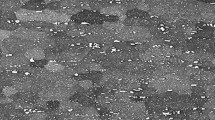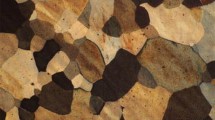Abstract
Temperature and solute concentration effects on the friction stress, σo, of cast (texture-free) polycrystals of pure Mg, and of Mg-Al, -Zn and -Gd binary solid solutions are discussed using phenomenological arguments. The temperature effects on the pure metal suggest that σo relates to the ratio between the CRSS of prism and basal slip, against early suggestions that it should only relate to the CRSS for basal slip. Solid solution softening upon prism slip accounts for the minima in σo at ~ 0.5 at. pct in Mg-Zn and Mg-Gd alloys. In the concentrated alloys, solute-specific hardening effects upon slip and twinning lead to diverging behaviors: in Mg-Al and Mg-Zn, σo remains below that of pure Mg. Strong short-range order by Gd leads to a steep monotonic increase, and to a value larger in compression than in tension due to the activation of {10-11} twinning at high concentrations. The negative σo of the dilute Mg-Zn alloys is an artifact created by the tension/compression asymmetry stemming from the polar character of {10-12} twinning.








Similar content being viewed by others
Notes
The data sets of Mg, Mg-Zn, and Mg-Gd in Figures 1 through 3 were collected in the present authors’ experimental facilities using the same molds, casting and testing techniques. Still, the data presented significant scatter, as can be appreciated by the variation in σo and k for pure Mg. A large experimental scatter seems to be a feature of Mg and its alloys, likely to be connected with the plastic anisotropy. See Reference [2] for a more detailed discussion.
Mecking et al.[25] pointed out that preferential strain hardening of the softer slip systems decreases the anisotropy of plastically anisotropic materials as the material is deformed. (A similar, only more empirical, analysis was recently put forward by Hutchinson and Barnett.[26]) Mecking et al.’s analysis was used by Caceres and Lukac[21] to estimate the Taylor factor of Mg polycrystals used for Eq. [3] and in Figure 4.
Gharghouri et al.[28] pointed out that the onset of deformation through basal slip leading to pileups on grain boundaries should lead to a periodic long range stress with a wave length equal to the polycrystal’s grain size.
Akhtar and Teghtsoonian[22] argued that the solid solution softening stems from the creation of kinks in the edge components of the dislocations lying on the prism planes. The kinks so created facilitate thermally activated slip of otherwise straight and virtually immobile dislocations pinned down by the Peierls–Nabarro force. As such, they argued it should be a general, i.e., independent of the c/a ratio, valence, or atomic size, solid solution effect.
Note that unlike the argument by which the profuse activation of twinning inside the hard oriented grains lowers the k-value through the increased slip flexibility (cf. section on the stress intensity factor), the t/c asymmetry is a geometric effect reflecting the proportion of grains in which twinning is activated for given stress, i.e., the number density of twins in the grains involved is not necessarily affected. That is, the increased amount of twinning in compression is not expected to reduce the k-value in comparison with tension (see Eqs. [6] through [8]).
The assumption k*=0 for the twinning grains can only represent a transient situation, as eventually plastic strain will involve all, twinning and non-twinning, grains in the aggregate. When this happens, due to twinning’s grain partition effects, the twinned grains will appear to be smaller, adding to the overall strain hardening through an enhanced Hall–Petch effect. The Hall–Petch hardening due to grain partition through twinning has been discussed elsewhere,[37] and shown to be relatively small because of the relatively large size of twins in Mg, in turn, stemming from the small twinning shear strain involved.
References
C.H. Caceres, G.E. Mann, and J.R. Griffiths: Metall. Mater. Trans. A 2011, vol. 42A, pp. 1950-59.
D. Nagarajan, C.H. Caceres, and J.R. Griffiths: Metall. Mater. Trans. A 2016, vol. 47A, pp. 5401-08.
J.P. Weiler, J.T. Wood, R.J. Klassen, R. Berkmortel, and G. Wang: J. Mater. Sci. 2005, vol. 40, pp. 5999-6005.
A. Akhtar and E. Teghtsoonian: Trans. Jpn. Inst. Metals 1968, vol. 9, supplement, pp. 692-97.
E.W. Kelley and W.F. Hosford: Trans. Metall. Soc. AIME 1968, vol. 242, pp. 5-13.
S.R. Agnew, M.H. Yoo, and C.N. Tomé: Acta Mater. 2001, vol. 49, pp. 4277-89.
C.H. Cáceres and A. Blake: Phys. Status Solidi 2002, vol. 194, pp. 147-58.
C.H. Cáceres and D.M. Rovera: J. Light Metals 2001, vol. 1/3, pp. 151-56.
S. Abaspour and C.H. Caceres: Metall. Mater. Trans. A 2015, vol. 46A, pp. 5972-88.
S. Abaspour and C.H. Caceres: Metall. Mater. Trans. A 2016, vol. 47A, pp. 1313-21.
S. Abaspour, V. Zambelli, M. Dargusch, and C.H. Cáceres: Mater. Sci. Eng. A 2016, vol. 673, pp. 114-21.
B. Raeisinia and S.R. Agnew: Scr. Mater. 2010, vol. 63, pp. 731-36.
R.W. Armstrong, in: T.N. Baker (Ed.) Yield, Flow and Fracture of Polycrystals, Applied Science Publishers, London, 1983, pp. 1-31.
T.N. Baker, in: T.N. Baker (Ed.) Yield, Flow and Fracture of Polycrystals, Applied Science Publishers, London, 1983, pp. 235-73.
R. Armstrong, I. Codd, R.M. Douthwaite, and N.J. Petch: Philos. Mag. 1962, vol. 7, pp. 45-58.
R.W. Armstrong: Acta Metall.1968, vol. 16, pp. 347-55.
R.W. Armstrong, in: J.C.M. Li (Ed.) Mechanical Properties of Nanocrystalline Materials, Pan Stanford Publishing, C/o World Scientific Publishing Co., Inc., Hackensack, 2009.
F.E. Hauser, P.R. Landon, and J.E. Dorn: Trans. Am. Soc. Metals 1956, vol. 48, pp. 986-1002.
F.E. Hauser, P.R. Landon, and J.E. Dorn: Trans. Metall. Soc. AIME 1956, vol. 206, pp. 589-93.
A. Akhtar and E. Teghtsoonian: Acta Metall. 1969, vol. 17, pp. 1339-49.
C.H. Cáceres and P. Lukác: Philos. Mag. A 2008, vol. 88, pp. 977-89.
A. Akhtar and E. Teghtsoonian: Acta Metall. 1969, vol. 17, pp. 1351-56.
N. Ono, R. Nowak, and S. Miura: Mater. Lett. 2004, vol. 58, pp. 39-43.
A. Jain, O. Duygulu, D.W. Brown, C.N. Tomé, and S.R. Agnew: Mater. Sci. Eng. A 2008, vol. 486, pp. 545-55.
H. Mecking, U.F. Kocks, and C. Hartig: Scr. Mater. 1996, vol. 35, pp. 465-71.
W.B. Hutchinson and M.R. Barnett: Scr. Mater. 2010, vol. 63, pp. 737-40.
U.F. Kocks: Metall. Trans. 1970, vol. 1, pp. 1121-43.
M.A. Gharghouri, G.C. Weatherly, J.D. Embury, and J. Root: Philos. Mag. 1999, vol. 79, pp. 1671-96.
S.R. Agnew, D.W. Brown, and C.N. Tome: Acta Mater. 2006, vol. 54, pp. 4841-52.
S.R. Agnew, C.N. Tomé, D.W. Brown, T.M. Holden, and S.C. Vogel: Scr. Mater. 2003, vol. 48, pp. 1003-08.
U.F. Kocks and D.G. Westlake: Trans. AIME 1967, vol. 239, pp. 1107-09.
J. Koike: Metall. Mater. Trans. A 2005, vol. 36A, pp. 1689-96.
O. Muránsky, D.G. Carr, P. Sittner, and E.C. Oliver: Int. J. Plast. 2009, vol. 25, pp. 1107-27.
D.V. Wilson and J.A. Chapman: Philos. Mag. 1963, vol. 8, pp. 1543-51.
D.V. Wilson: J. Inst. Metals 1966, vol. 98, pp. 133-43.
G. Sambasiva Rao and Y.V.R.K. Prasad: Metall. Trans.A 1982, vol. 13A, pp. 2219-26.
C.H. Cáceres, P. Lukác, and A. Blake: Philos. Mag. A 2008, vol. 88, pp. 991-1003.
G.-W. Chang, S.-Y. Chen, C. Zhou, X.-D. Yue, and Y.-h. Qi: Trans. Nonferrous Metals Soc. China 2010, vol. 20, pp. 289-93.
D. Kuhlmann-Wilsdorf: Metall. Mater. Trans. A 2004, vol. 35A, pp. 369-418.
C.H. Cáceres and A.H. Blake: Mater. Sci. Eng. A 2007, vol. 462, pp. 193-96.
C.H. Cáceres, J.R. Griffiths, C.J. Davidson, and C.L. Newton: Mater. Sci. Eng. 2002, vol. 325, pp. 344-55.
U.F. Kocks: P. Haasen, V. Gerold and G. Kostorz (Ed.) Strength of Metals and Alloys (ICSMA-5), Aachen, DR; Pergamon Press, New York, 1980, pp. 1661-80.
P. Lukáč: Czechoslov. J. Phys. B 1981, vol. 31, pp. 135-41.
S. Ando and H. Tonda: Mater. Sci. Forum 2003, vol. 419-422, pp. 87-92.
S. Ando and H. Tonda: Mater. Trans. (JIM) 2000, vol. 41, pp. 1188-91.
B.L. Wu, Y.H. Zhao, X.H. Du, Y.D. Zhang, F. Wagner, and C. Esling: Mater. Sci. Eng. A 2010, vol. 527, pp. 4334-40.
Z. Wu, R. Ahmad, B. Yin, S. Sandlöbes, and W.A. Curtin: Science 2018, vol. 359, pp. 447-52.
A. Seeger, in: J.C. Fisher, W.G. Johnston, R. Thomson and T. Vreeland (Ed.) Dislocations and Mechanical Properties of Crystals, Chapman and Hall, London, 1957), pp. 243-329.
B. Raeisinia, S.R. Agnew, and A. Akhtar: Metall. Mater. Trans. A 2011, vol. 42A, pp. 1418-4130.
S. Graff, W. Brocks, and D. Steglich: Int. J. Plast. 2007, vol. 23, pp. 1957-78.
G.E. Mann, T. Sumitomo, C.H. Cáceres, and J.R. Griffiths: Mater. Sci. Eng. A 2007, vol. 456, pp. 138-46.
K.J. Kurzydlowski and J.J. Bucki: Acta Metall. et Mater. 1993, vol. 41, pp. 3141-46. https://doi.org/10.1016/0956-7151(3193)90044-s
D. Nagarajan, C.H. Caceres, and J.R. Griffiths: Acta Phys. Polonica A 2012, vol. 122, pp. 501-04.
C.H. Cáceres, T. Sumitomo, and M. Veidt: Acta Mater. 2003, vol. 51, pp. 6211-18.
A. Kelly: Strong Solids, Clarendon Press, Oxford, 1973.
D. Nagarajan: Mater. Sci. Eng. A 2017, vol. 695, pp. 14-19.
J.D. Embury, in: A. Kelly and R.B. Nicholson (Ed.) Strengthening Methods in Crystals, Elsevier, London, 1972, pp. 331-402.
I. Baker and E.M. Schulson: Scr. Metall. 1989, vol. 23, pp. 345-48.
F.R.N. Nabarro and F. de Villiers: Physics of Creep and Creep-Resistant Alloys, Taylor & Francis, London, 1995.
K. Hantzsche, J. Bohlen, J. Wendt, K.U. Kainer, S.B. Yi, and D. Letzig: Scr. Mater. 2010, vol. 63, pp. 725-30.
N. Stanford, D. Atwell, and M.R. Barnett: Acta Mater. 2010, vol. 58, pp. 6773-83.
N. Stanford and M.R. Barnett: Mater. Sci. Eng. A 2008, vol. 496, pp. 399-408.
J.D. Robson, A.M. Twier, G.W. Lorimer, and P. Rogers: Mater. Sci. Eng. A 2011, vol. 528, pp. 7247-56.
J. Zhang, M. Liu, Y. Dou, and G. Liu: Metall. Mater. Trans. A 2014, vol. 45A, pp. 5499-5507.
D. Nagarajan, X. Ren, and C.H. Caceres: Mater. Sci. Eng. A 2017, vol. 696, pp. 387-92.
D. Nagarajan, X. Ren, C.H. Caceres, and J.R. Griffiths: Mg 2012: 9th International Conference on Magnesium Alloys and their Applications, University of British Columbia, Vancouver, 2012, pp. 559-63.
ASTM, (ASTM International, 2002), vol. E562-02, pp. 1-7.
Author information
Authors and Affiliations
Corresponding author
Additional information
Manuscript submitted May 22, 2017.
Appendix A
Appendix A
1.1 Quantitative Metallography of Twinning (Mg-1.5Gd Alloy)
The procedure was similar to that used in earlier studies on Mg-Zn and Mg-Al alloys.[65,66] Flat tensile specimens with a cross section of 5 × 6 mm2 and a gauge length of 25 mm were machined from cast and heat-treated bars. One face was polished to 0.04 μm and examined to verify that no twins had been formed as a result of the polishing. The samples were then deformed to strains of 0.1, 0.5, 1, and 2 pct. After each straining step, the specimens were cleaned ultrasonically in ethanol. Optical micrographs using Nomarski interference contrast, of which an example is in Figure A1, were taken at every 2 mm along and across the gauge length, obtaining between 25 and 36 fields of view for each strain. The volume and number fraction of twins were measured according to ASTM E562-02.[67] To avoid observer’s bias, a number of measurements were repeated by the co-authors. A relative accuracy ranging from 7 to 23 pct was maintained for all measurements. It is noted that this procedure, with comparable resolution, is vastly superior to EBSD in two accounts: time efficiency (the whole set of experiments was carried out in two days), and, since the entire specimens were covered, the statistics are more credible.
Rights and permissions
About this article
Cite this article
Nagarajan, D., Cáceres, C.H. The Friction Stress of the Hall–Petch Relationship of Pure Mg and Solid Solutions of Al, Zn, and Gd. Metall Mater Trans A 49, 5288–5297 (2018). https://doi.org/10.1007/s11661-018-4810-1
Received:
Published:
Issue Date:
DOI: https://doi.org/10.1007/s11661-018-4810-1





